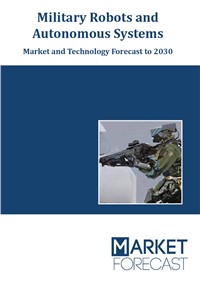The ongoing conflict in Ukraine has once again drawn the attention of military planners towards military robots and autonomous systems. Military robots are autonomous robots or remote-controlled mobile robots created for military functions, from transport to search & rescue and strike mission. Some of these robotic systems are presently in use, and several such robots are under development. These military robots and autonomous systems just rolling out or already in prototype stage are far more proficient, logical, and autonomous than ones now in Iraq and Afghanistan. As new add-ons are developed, military robots will be able to take on a wider set of battlefield roles. As of now the United States military remains the largest user of these robots, however countries like China and Russia are investing billions in robotics research and development that will allow them to narrow the gap with the US.
Market Forecast’s latest report “Global Military Robots and Autonomous Systems - Market and Technology Forecast to 2030” examines, analyzes, and predicts the evolution of airborne military robot systems, technologies, markets, and outlays (expenditures) over the next 8 years – 2022 -2030 in the military robots and autonomous system industry. It also examines military robot markets geographically, focusing on the top 95% of global markets, in the United States, Europe, and Asia.
Throughout the report we show how military robots and autonomous systems are used today to add real value. To provide the most thorough and realistic forecast, this report provides a twin-scenario analysis, including “steady state”, emergence of new military robot and autonomous system technology.
Scope
- Overview: Snapshot of the various military robots and autonomous system tech in the defense market during 2022-2030, including highlights of the demand drivers, trends, and challenges. It also provides a snapshot of the spending with respect to regions as well as segments. It also sheds light on the emergence of new technologies
- Market Dynamics: Insights into the technological developments in this market and a detailed analysis of the changing preferences of governments around the world. It also analyzes changing industry structure trends and the challenges faced by the industry participants.
- Segment Analysis: Insights into the various Systems market from a segmental perspective and a detailed analysis of factors influencing the market for each segment.
- Regional Review: Insights into modernization patterns and budgetary allocation for top countries within a region.
- Regional Analysis: Insights into the Systems market from a regional perspective and a detailed analysis of factors influencing the market for each region.
- Trend Analysis: Key military robots and autonomous system markets: Analysis of the key markets in each region, providing an analysis of the various Systems segments expected to be in demand in each region.
- Key Program Analysis: Details of the top programs in each segment expected to be executed during the forecast period.
- Competitive landscape Analysis: Analysis of competitive landscape of this industry. It provides an overview of key companies, together with insights such as key alliances, strategic initiatives, and a brief financial analysis.
Segmentation
In this report we have classified military robots and autonomous system industry under 5 major groups. We will research these six major groups and also provide forecast figures from 2022 -2030. These are:Region
- Americas
- Europe
- Asia
- Middle East
- Africa
Software Technologies
- Computer Vision
- Natural Language Processing
- Edge Computing
- Complex Event Process
- Transfer Learning AI
- Hardware Acceleration for AI
- Reinforcement Learning
- Generative Adversarial Networks (GANs)
- Mixed Reality
- Emotion research – affective computing
Hardware Technologies
- Power Source
- Actuation
- Sensing
- Manipulation
- Locomotion
- Environmental Interaction & Navigation
- Human Robot Interaction
- Control
Application
- Intelligence, Surveillance and Reconnaissance (ISR)
- Search and Rescue
- Combat
- Transportation
- Explosive Ordnance Disposal
- Mine Clearance
- Firefighting
- Others
Operation
- Fully Autonomous
- Semi-Autonomous
Platform
- Land Based Platforms
- Air Based Platforms
- Sea Based Platforms
End User:
- Army
- Air Force
- Navy
Reasons to buy
- Determine prospective investment areas based on a detailed trend analysis of the Global Military Robots & Autonomous System Market over the next eight years
- Gain in-depth understanding about the underlying factors driving demand for different systems segments in the top spending countries across the world and identify the opportunities offered by each of them
- Strengthen your understanding of the market in terms of demand drivers, industry trends, and the latest technological developments, among others
- Identify the major channels that are driving the global small sat business, providing a clear picture about future opportunities that can be tapped, resulting in revenue expansion
- Channelize resources by focusing on the ongoing programs that are being undertaken by the ministries of different countries within the small sat market
- Make correct business decisions based on thorough analysis of the total competitive landscape of the sector with detailed profiles of the top systems providers around the world which include information about their products, alliances, recent contract wins and financial analysis wherever available




